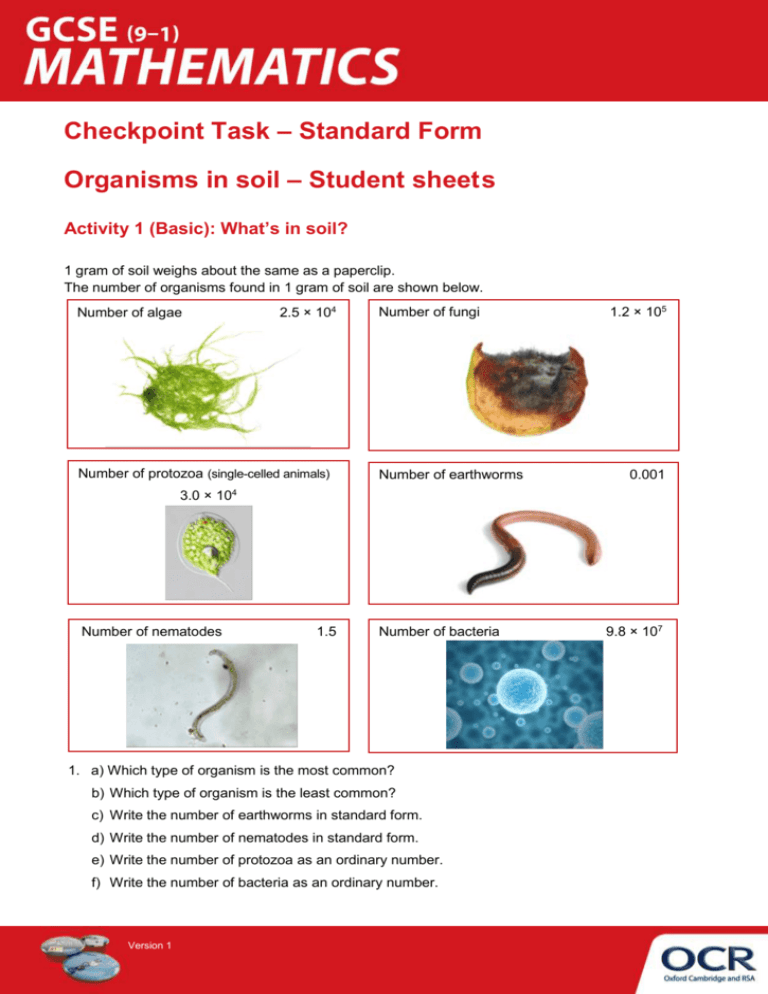GCSE (9-1) Mathematics, Organisms in soil
advertisement

Checkpoint Task – Standard Form Organisms in soil – Student sheet s Activity 1 (Basic): What’s in soil? 1 gram of soil weighs about the same as a paperclip. The number of organisms found in 1 gram of soil are shown below. 2.5 × 104 Number of algae Number of protozoa (single-celled animals) Number of fungi Number of earthworms 1.2 × 105 0.001 4 3.0 × 10 Number of nematodes 1.5 Number of bacteria 1. a) Which type of organism is the most common? b) Which type of organism is the least common? c) Write the number of earthworms in standard form. d) Write the number of nematodes in standard form. e) Write the number of protozoa as an ordinary number. f) Write the number of bacteria as an ordinary number. Version 1 9.8 × 107 2. a) Write these six organisms in order giving the largest number first. Put your results in the table below. Name Number in standard form b) A scientist says these values should be given as dry weights. In a cubic metre of soil the dry weight of the organisms are: algae 3.2 × 101 g bacteria 160 g earthworms 80 g fungi 2.0 × 102 g nematodes 12 g protozoa 3.8 × 101 g 1m 1m 1m (i) Which organism has the highest dry weight? (ii) Which organism has the lowest dry weight? 3. Earthworms can eat up to 5 × 103 bacteria in one minute. If an earthworm ate constantly, what is the maximum number of bacteria it could eat in 24 hours? Write your answer in standard form. Version 1 Activity 2 (Understanding indices): The farmer’s field 1. Sarah and Toby want to calculate 8 × 106 + 7 × 106. Sarah writes Toby writes 8 × 106 + 7 × 106 8 × 106 + 7 × 106 = 15 × 1012 = (8 + 7) × 106 = 1.5 × 101 × 1012 = 15 × 106 factorising = 1.5 × 1013 a) What did Sarah do wrong? b) What did Toby forget to do? c) Write out the correct answer. 2. Sarah and Toby now want to calculate 5 × 1016 – 8 × 1014. Sarah says that Toby is Toby writes right so far. 5 × 1016 – 8 × 1014 = 5 × 102 × 1014 – 8 × 1014 = (5 × 102 – 8) × 1014 = (5 × 100 – 8) × 1014 factorising Sarah says: Work out the brackets. Write the answer in standard form. Finish the calculation. Version 1 3. Write your answers to this question in standard form. a) The length of Field A = 7 × 102 m. The width of Field A = 5 × 102 m. Not to scale Field A (i) Find the area of Field A. (ii) Find the perimeter of Field A. b) The length of Field B = 9 × 102 m. The width of Field B = 2 × 101 m. Field B Not to scale (i) Find the area of Field B. (ii) Find the perimeter of Field B. c) Which field, A or B, has the bigger area and by how much? Version 1 Activity 3 (Challenge): How small are bacteria? 1. These spherical staphylococcus bacteria can be found in the soil. Most are harmless. The scale on the picture gives 2 µm which is equal to 2 × 10-6 metres. a) Find the diameter and radius of one spherical staphylococcus. b) Use the formula below to find the volume of one spherical staphylococcus. Volume = 4 3 πr 3 Hint: The formula can be written Volume = Version 1 4 22 π r 3 where = 7 3 2. The diagram shows three grains of salt. Each grain of salt is a cube. a) What is the length of one grain of salt in metres? b) What is the volume of one grain of salt in cubic metres? 3. How many staphylococcus bacteria would make up a volume equal to the volume of one grain of salt? Version 1 Task 4 (Research): Soil and worm-casts 1. Earthworms bring soil to the surface, forming worm-casts. If this soil could be spread evenly over the surface, what would the increase in height of the surface be in 500 years? Let’s look at the problem in stages for an area of 1 hectare … a) There is an average of 3.6 × 102 earthworms in 1 hectare = 104 square metres 1 square metre of grassland soil. How many earthworms are there in 1 hectare? b) What is the weight of soil brought to the surface in 1 hectare, by these earthworms? The record weight of an earthworm is 11.2 g! However, the average weight is roughly 5 g. Give your answer in kilograms and in standard form. An earthworm can bring its own weight of soil to the surface every 24 hours. c) Change this weight into cubic metres, to give 1 m3 of soil weighs 1.6 × 103 kg. the volume of soil brought to the surface in 1 hectare. d) Use this formula and solve by rearranging to find the increase in the depth of the soil in 24 Volume of a hectare of soil = area of the surface of 1 hectare × depth hours. e) Use your answer to find what the increase in depth of the soil would be in (i) 1 year, (ii) 500 years. f) Your answers to part e) are significantly overestimated. Why? Version 1







